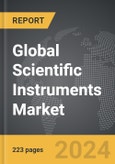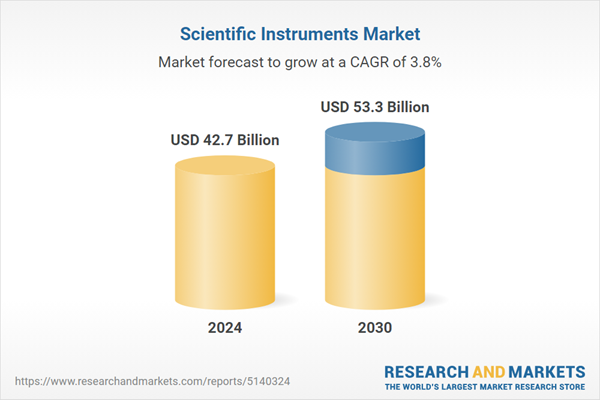The global market for Scientific Instruments was valued at USD 42.7 Billion in 2024 and is projected to reach USD 53.3 Billion by 2030, growing at a CAGR of 3.8% from 2024 to 2030. This comprehensive report provides an in-depth analysis of market trends, drivers, and forecasts, helping you make informed business decisions.
Global Scientific Instruments Market - Key Trends and Drivers Summarized
Scientific Instruments: What Drives the Innovation and Demand in This Dynamic Market?
Scientific instruments are essential tools in research, diagnostics, quality control, and various analytical applications across multiple industries, including pharmaceuticals, biotechnology, healthcare, environmental monitoring, and food and beverage. The market for scientific instruments is diverse, encompassing spectrometers, chromatography systems, microscopes, and thermal analyzers, among others. The demand for these instruments is driven by the ongoing expansion of research and development activities, especially in life sciences and healthcare. Increased government funding and private investments in scientific research are significantly boosting the adoption of advanced instruments. The rising need for precision and accuracy in laboratory testing and analysis is further propelling the market, as scientific instruments play a critical role in ensuring reliable and reproducible results.How Are Technological Advancements Shaping the Scientific Instruments Market?
Technological advancements are revolutionizing the scientific instruments market, driving innovation and expanding applications. The integration of artificial intelligence (AI) and machine learning (ML) in scientific instruments is enabling automated data analysis and enhancing the efficiency and accuracy of research processes. Developments in digital technologies, such as the Internet of Things (IoT) and cloud computing, are allowing real-time monitoring and remote operation of laboratory instruments, improving productivity and reducing operational costs. Additionally, the miniaturization of analytical devices is creating opportunities for portable and handheld instruments, which are increasingly being adopted in field research and point-of-care testing. These technological trends are reshaping the market landscape, making scientific instruments more versatile and accessible to a broader range of users.What Market Trends Are Emerging in the Field of Scientific Instruments?
The scientific instruments market is witnessing several emerging trends that are influencing its growth trajectory. The rising focus on personalized medicine and genomics is driving the demand for specialized instruments, such as next-generation sequencing (NGS) systems and CRISPR gene-editing tools, which enable more targeted and precise research outcomes. The growing emphasis on environmental monitoring, fueled by global climate change concerns, is increasing the need for advanced analytical instruments capable of detecting and quantifying pollutants and toxins. Additionally, there is a growing trend towards collaboration between instrument manufacturers and research institutions to co-develop customized solutions that meet specific research needs. The adoption of subscription-based models and leasing options for high-cost instruments is also gaining popularity, enabling smaller laboratories and startups to access advanced technologies without heavy capital investment.What Drives the Growth in the Scientific Instruments Market?
The growth in the scientific instruments market is driven by several factors, including technological innovations, increasing demand in various end-use industries, and expanding research activities globally. The rapid advancements in genomics, proteomics, and molecular biology are generating substantial demand for high-precision instruments such as mass spectrometers, chromatography systems, and real-time PCR machines. The rising prevalence of chronic diseases and the need for early diagnosis are propelling the adoption of diagnostic instruments in healthcare. The expansion of environmental regulations and the growing need for food safety testing are further driving the demand for analytical instruments in environmental monitoring and food and beverage industries. Moreover, the shift towards automation in laboratories and the integration of digital solutions to enhance data accuracy and workflow efficiency are major growth drivers in this market.Report Scope
The report analyzes the Scientific Instruments market, presented in terms of market value (USD Thousand). The analysis covers the key segments and geographic regions outlined below.Segments
Type (Scientific Clinical Analysers, Scientific Analytical Instruments, Other Types); End-User (Research, Clinical & Diagnostics, Other End-Users).Geographic Regions/Countries
World; United States; Canada; Japan; China; Europe (France; Germany; Italy; United Kingdom; and Rest of Europe); Asia-Pacific; Rest of World.Key Insights:
- Market Growth: Understand the significant growth trajectory of the Scientific Clinical Analysers segment, which is expected to reach $31.4 Billion by 2030 with a CAGR of a 4.7%. The Scientific Analytical Instruments segment is also set to grow at 2.8% CAGR over the analysis period.
- Regional Analysis: Gain insights into the U.S. market, valued at $11.4 Billion in 2024, and China, forecasted to grow at an impressive 3.6% CAGR to reach $8.5 Billion by 2030. Discover growth trends in other key regions, including Japan, Canada, Germany, and the Asia-Pacific.
Report Features:
- Comprehensive Market Data: Independent analysis of annual sales and market forecasts in USD from 2024 to 2030.
- In-Depth Regional Analysis: Detailed insights into key markets, including the U.S., China, Japan, Canada, Europe, Asia-Pacific, Latin America, Middle East, and Africa.
- Company Profiles: Coverage of major players such as Agar Scientific Ltd., Agilent Technologies, Inc., ALPHA CHEMIKA, Angstrom Advanced, Inc., Athena Technology and more.
- Complimentary Updates: Receive free report updates for one year to keep you informed of the latest market developments.
Why You Should Buy This Report:
- Detailed Market Analysis: Access a thorough analysis of the Global Scientific Instruments Market, covering all major geographic regions and market segments.
- Competitive Insights: Get an overview of the competitive landscape, including the market presence of major players across different geographies.
- Future Trends and Drivers: Understand the key trends and drivers shaping the future of the Global Scientific Instruments Market.
- Actionable Insights: Benefit from actionable insights that can help you identify new revenue opportunities and make strategic business decisions.
Key Questions Answered:
- How is the Global Scientific Instruments Market expected to evolve by 2030?
- What are the main drivers and restraints affecting the market?
- Which market segments will grow the most over the forecast period?
- How will market shares for different regions and segments change by 2030?
- Who are the leading players in the market, and what are their prospects?
Some of the 46 major companies featured in this Scientific Instruments market report include:
- Agar Scientific Ltd.
- Agilent Technologies, Inc.
- ALPHA CHEMIKA
- Angstrom Advanced, Inc.
- Athena Technology
- Australian Scientific Instruments Pty Limited
- Azzota Corporation
- Bio Molecular Systems
- Bio-Active Co., Ltd.
- Biospherical Instruments Inc.
Table of Contents
I. METHODOLOGYII. EXECUTIVE SUMMARY2. FOCUS ON SELECT PLAYERSIII. MARKET ANALYSISIV. COMPETITION
1. MARKET OVERVIEW
3. MARKET TRENDS & DRIVERS
4. GLOBAL MARKET PERSPECTIVE
UNITED STATES
CANADA
JAPAN
CHINA
EUROPE
FRANCE
GERMANY
ITALY
UNITED KINGDOM
REST OF EUROPE
ASIA-PACIFIC
REST OF WORLD
Companies Mentioned (Partial List)
A selection of companies mentioned in this report includes, but is not limited to:
- Agar Scientific Ltd.
- Agilent Technologies, Inc.
- ALPHA CHEMIKA
- Angstrom Advanced, Inc.
- Athena Technology
- Australian Scientific Instruments Pty Limited
- Azzota Corporation
- Bio Molecular Systems
- Bio-Active Co., Ltd.
- Biospherical Instruments Inc.
Table Information
| Report Attribute | Details |
|---|---|
| No. of Pages | 223 |
| Published | March 2025 |
| Forecast Period | 2024 - 2030 |
| Estimated Market Value ( USD | $ 42.7 Billion |
| Forecasted Market Value ( USD | $ 53.3 Billion |
| Compound Annual Growth Rate | 3.8% |
| Regions Covered | Global |









